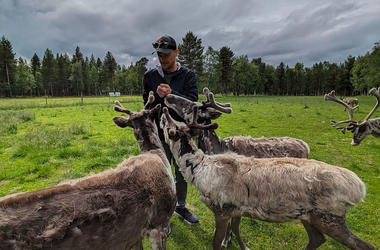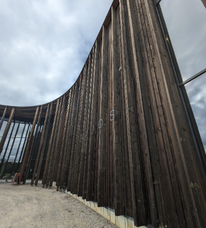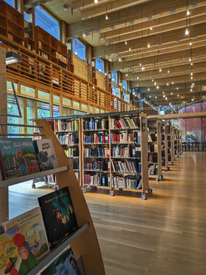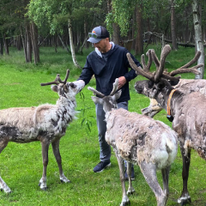
Travel helps expand Sámi programming at UMD
Posted: September 18, 2023The Kathryn A. Martin Library at the University of Minnesota Duluth has one of the largest Sámi collections in the world, with thousands of books, films, and other items related to the indigenous people of northern Scandinavia. Library Director Matt Rosendahl recently traveled to Sápmi, the traditional lands of the Sámi people, to visit cultural centers, museums, and libraries and meet with people working to preserve Sámi language and culture.
“There’s a long list of cultural, environmental, and historical programming we’re going to develop over the next few years that comes from a deeper and more nuanced understanding of not only the history, but the ways that Sámi people experience contemporary issues,” Rosendahl said.
Rosendahl highlighted the work on climate change that is happening in Sápmi, such as the Zero Arctic Project, which examined how to learn from traditional knowledge and the ideas of traditional construction in designing climate-friendly buildings. The project focused on Northern Finland, Canada, and Japan, with an emphasis on cooperations with the indigenous people of the regions.
“There’s a lot to be learned from what’s happening in Sápmi that can be applied here in northern Minnesota — and, in fact, connected with work that’s also happening here,” he said.
Rosendahl, who received an international travel grant from the Global Programs and Strategy Alliance to support the trip, visited Inari and Sevettejarvi, Finland, and Karasjok and Neiden, Norway.

He explained that similar to the term Native American, Sámi actually refers to a wide variety of people with different languages and visible differences in their shared culture, such as the clothing designs and their meanings that vary between the Inari Sámi, Northern Sámi, and Skolt Sámi visited during the trip, as well as the other Sámi groups in the region. Part of the goal of the trip was to explore the different areas where those cultures are rooted and meet with people from multiple communities.
In Inari, Rosendahl and his colleague Chelsey Miller visited the Sámi Parliament, or Sámediggi, which is the supreme political body of the Sámi in Finland. The parliament has authority over anything related to Sámi culture and language. For example, they have worked to require that the Finnish government make public services, such as healthcare, accessible in the Sámi language.

They also visited Norway’s Sámi Parliament and toured the library, getting to see some of the first books written by Sámi people about Sámi culture. The library director discussed with them how the Kathryn A. Martin Library can better share records and make its collection more discoverable to researchers worldwide.
Exploring the natural areas was another highlight for Rosendahl. He was amazed by how much Sápmi looks like northern Minnesota. A disproportionately high number of Finns settled in Minnesota, and he could see why.
“The forests, lakes, boreal landscape — it just really felt like home, with the exception of the reindeer,” Rosendahl said.
Before leaving on the trip, Rosendahl told people how much he hoped to see a reindeer.
“It turns out they’re everywhere,” he laughed. “It’s like how driving around the woods in Minnesota we worry about hitting a white-tailed deer. Reindeer are along the roads. They wander into town.”

Rosendahl and Miller even got the chance to spend time with a reindeer herder and learn about the issues facing the traditional practice. Finnish regulations like a cap on the number of reindeer each family can herd and how many children in each family can become herders are meant to help with ecological balance, but they are also impacting the Sámi way of life.
The indigenous experience is of particular interest to Rosendahl, especially as it compares to that of the native communities of northern Minnesota.
“In the past, I too often made an indigenous to indigenous connection or comparison in my thinking,” he said. “While there are similarities for indigenous peoples’ experiences in this world, there are also important differences. This contrast became very apparent to me while I was there.”
Rosendahl explained that the current experiences of the Sámi and Ojibwe are very different. For example, the Sámi do not have sovereignty and land rights.
“Comparing native community to native community flattens and doesn’t do justice to people and their history, culture, and the unique issues they face today,” Rosendahl said. “At the same time, there are things that can be shared and we can learn from.”
One Minnesotan with Sámi heritage is central to the library’s collection. Rudy Johnson served as director of the Kathryn A. Martin Library from 1959 to 1975. Rudy and his wife Solveig rediscovered their Sámi heritage and were important figures of the Sámi Reawakening, a cultural movement to reclaim Sámi identity in the United States that began in the early ’90s. The couple helped countless people in the Duluth area reconnect with their Sámi heritage, including by hosting cultural events.
After Rudy Johnson passed away in 2007, his successor Don Pearce began donating funds to build a Sámi collection in his memory. The collection has grown to more than 380,000 books, journals, films, and other items since then, and continues to expand as the library adds more resources that reflect Sámi perspectives and lives.
One of Rosendahl’s destinations in Sápmi also has ties to Johnson. His grandfather was born in Karasjok, Norway.
“To have this kind of full circle experience and initiate connections between our institution and Sápmi is something I had thought about and dreamed about for many years,” Rosendahl said.
 Global
Global